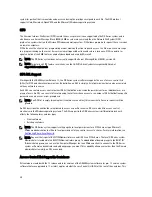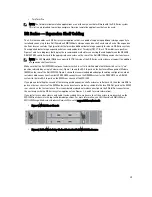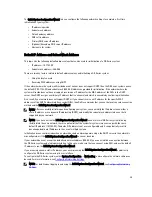
exists, only the pointers need to be updated on the DR Series system, and the duplicate chunk of data does not need to
be transferred to the system. This process provides two benefits: it improves the overall backup speed, and also reduces
the network load.
When OST is used with the DR Series system, it offers the following benefits:
•
OST protocol provides faster and improved data transfers:
– Focused on backups with minimal overhead
– Accommodates larger data transfer sizes
– Provides throughput that is significantly better than CIFS or NFS
•
OST and DMA integration:
– OpenStorage API enables the DMA-to-media server software communications
– DR Series system storage capabilities can be used without extensive changes to DMAs
– Backup and replication operations are simplified by using built-in DMA policies
•
DR Series System and OST:
– Control channel uses TCP port 10011
– Data channel uses TCP port 11000
– Optimized write operations enable client-side deduplication
•
Replication operations between DR Series systems:
– No configuration required on source or target DR Series systems
– Replication is file-based, not container-based
– Triggered by DMA optimized duplication operation
– DR Series system transfers the data file (not the media server)
– After duplication, DR Series system notifies DMA to update its catalog (acknowledging the second
backup)
– Supports different retention policies between source and replica
NOTE: This capability to use OST, also known as DR Rapid Data Access within Dell, adds tighter integration with
backup software applications, such as the two Symantec OpenStorage-enabled backup applications supported in
this release: NetBackup and Backup Exec.
OpenStorage Technology (OST) API
The OpenStorage Technology (OST) API is an application programming interface that allows disk-based devices like the
DR Series system to natively integrate with the two supported Symantec Data Management Applications (DMA),
NetBackup and Backup Exec. For example, because the DR Series system supports both data deduplication and
replication, the OST API allows these supported DMAs to use the DR Series system appliance features and duplicate the
optimized data from one storage appliance to another.
The OST API enables the writing of data to disk and is illustrated in the following example where NetBackup (the DMA)
interacts with the DR Series system (the data backup and deduplication device) using the OST API:
•
NetBackup needs to store a file to disk. To do this it notifies the DR Series system via the OST API which file it
needs to backup and what to name this file.
•
DR Series system accepts this file, backs it up, and stores it in its filesystem.
•
NetBackup can perform one of three subsequent operations with this specific stored file:
– Expire it
– Restore from it
24
Содержание PowerVault DX6112
Страница 1: ...Dell DR Series System Administrator Guide ...
Страница 32: ...32 ...
Страница 70: ...70 ...
Страница 86: ...86 ...
Страница 100: ...For more information on Replication schedules see Creating a Replication Schedule 100 ...
Страница 114: ...114 ...
















































